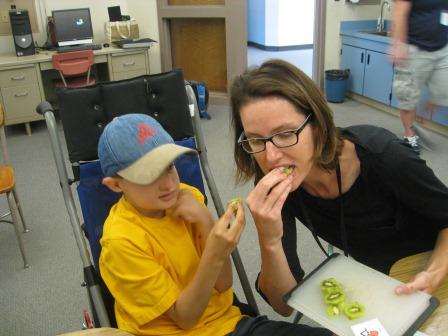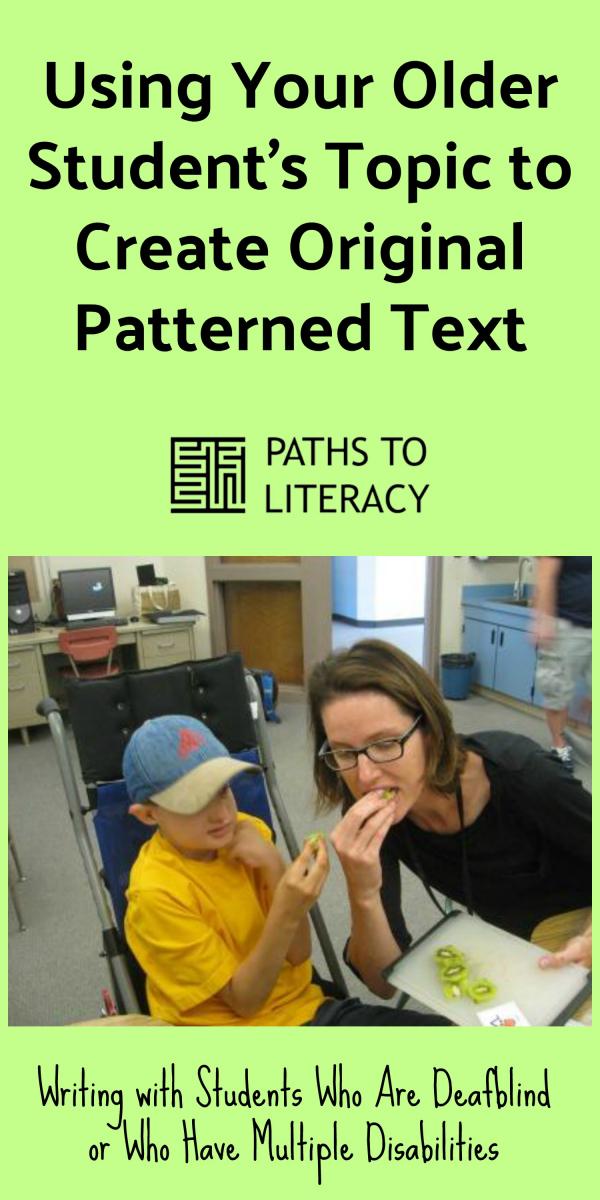Using Your Older Student's Topic to Create Original Patterned Text

by Megan Mogan, MS, CCC-SLP, Speech-Language Pathologist
In my last post we talked about using van Dijk’s coactive movement strategies to establish meaningful and enjoyable topics for our early communicators. Next I want to share a pretty simple strategy for using your experience-based movement activities to write Patterned Text. Many of you already use Patterned Text in your day-to-day literacy interactions with your students. Think “Brown Bear Brown Bear” by Bill Martin, where the same phrase or sentence repeats throughout the material while only one or two words change from page to page. You may also already use list poems, a form of patterned text with your early readers and writers. List Poems follow the same rule, changing only one word at a time while repeating the other word(s) line by line. Oftentimes board books for babies or toddlers follow a list poem or patterned approach as children at this stage of literacy development are reading using memory and rhythm with a parent or caregiver.
If you work with older students who are VI with multiple disabilities, you know many of these students are at this same stage of literacy development where they enjoy the rhythm and memory associated with predictable and patterned text. You also know that finding age-appropriate reading materials is a challenge! By age 16 (no offense Mr. Martin) “Brown Bear Brown Bear” has definitely run its course. When it comes to older students who are VI and have multiple disabilities, it seems you have two choices for literacy activities: 1) Find the least-insulting library book that matches up with your high school students’ early reading levels or 2) Stay after school until dark to make your own books and materials for your students.
Not too long ago, I decided to break it off with my weekly 6pm glue gun date. I started using coactive movement activities/experiences to generate original patterned text in real time (yes folks – that’s real as in paid-time, not 3-hours-after-contract time) with my students. This wasn’t anything I decided to do while sitting around analyzing data or going to expensive conferences. I wish. I am embarrassed to admit that I had to gag on a piece of Kiwi for the light bulb in my head to go off.
One day while taste-testing fruits with a student, he passed me a kiwi and waited expectantly for me to eat it. I looked at the kiwi, paused, looked back at my student and politely shook my head and said “No thanks.” My student looked at the kiwi. My student ate a piece of kiwi. My student looked at the remaining kiwi. My student looked back at me again. I slowly picked up a piece of kiwi. I slowly ate a piece of kiwi. I quickly gagged on the piece of kiwi. I hate kiwi. My student laughed hysterically. I continued gagging. My student continued laughing. And then he offered me another piece of kiwi! As you can tell, a very important conversation had just taken place. Only one of the turns used formal language (though it was accompanied by a non-language head shake), yet my student and I were about to use this exchange to make a permanent and patterned text that we would enjoy over and over.
It went something like:
Look! Kiwi.
Mmmm. Kiwi.
I Like Kiwi.
You like Kiwi?
Look! Kiwi.
Mmmm. Kiwi.
I eat Kiwi.
You eat Kiwi?
Look! Kiwi.
Mmmmm. Kiwi.
You eat Kiwi.
Look Kiwi.
Yuck Kiwi!
Yuck Kiwi!
Yuck Kiwi!
[Insert Gagging/Choking Sounds]
Want more Kiwi?
This text had a topic, action, description, rhythm, humor, suspense, sight words galore, and most importantly…a pattern. This meant my student had a high probability of successfully reading it! All from a simple experience that may have otherwise gone unnoticed (except for the gag reflex part).
Here’s a basic breakdown for Writing Patterned Texts:
- Have your student choose the topic through a shared experience
- Think about the word in your text that will be repeated. It can be an action word (e.g. go, like, look, etc.), a describing word (e.g. Delicious, Cool! Gross, etc.), a noun (e.g. kiwi, ball, Van Halen, etc.)
- Use the student’s eye gaze, actions, vocalizations, body turns, etc. to generate details for the text (e.g. Student looks at object = the word “look” or “I see”; Student reaches for an object = the words “want“ or “have”)
- Make sure your student has access to your turn in an exchange. A student who uses their hands to watch an action on an object or an expression on your face may process information about that action or emotion more efficiently than language alone.
- Take as many turns as possible during your interaction. Repeat. Repeat. Repeat. Remember you’re building a pattern and a rhythm. Pair language with your movements and turns (see #3).
-
Once you have your pattern of movements down, choose a way to document it based on your student’s learning media preference:
- Draw pictures
- Collect objects and act on them
- Make an audio recording
- Program a single-message Augmentative-Alternative Communication Device
- Braille it or Print it
- Make tactual symbols with your student
- Document the text with your student, not for them
- Read your finished product with your student. Then read it again.
The first time I read a patterned text with one of my older students I was amazed at his level of participation and engagement. He laughed and gestured. He anticipated the next part of the pattern. He asked to read it again and again. He took it home to read to his family by himself! I had combined the concepts of coactive movement activities with predictable and patterned text. I saved myself from the 6 pm walk-of-overworked-shame off campus and gave my student the dignity of being able to participate in literacy with joy. For that, I would eat a thousand kiwi fruits!


Comments
Look! Blog.
Play based writing
Connect
Tar Heel Reader
KIWI
Wonderful!